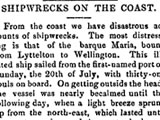Timeline Sections
What happened that day?
See historic events for any day of the year by entering the date below. Why not try your birthday?
Kiwi of the Week

1851 The Maria wrecked near Cape Terawhiti
Twenty-six lives were lost when the barque Maria was wrecked near Cape Terawhiti, on Wellington’s rugged south-western coast. This provided more ammunition for locals who were trying to convince the government of the need for a lighthouse.
The Maria left Port Cooper (Lyttelton) for Port Nicholson (Wellington) on 22 July 1851 with a crew of 22 and six passengers. Having conveyed stock from Charles Clifford’s sheep stations in Wairarapa and Marlborough, it was returning with just a few casks of sperm oil as ballast. Four of the passengers were stockmen.
On nearing Wellington Harbour the barque crossed a reef, and then, a few minutes later, struck a rock which pierced the hull. This was probably Thoms Rock, which has been identified as the cause of other wrecks over the years, including that of the SS Penguin. The barque soon broke across the waist and separated into two halves about 400 m from shore.
Those on board first tried to free a small boat, but the lowering mechanism gave way and it was smashed to pieces. Those not killed in this incident then salvaged material to use as rafts. Only two men eventually reached the shore safely. One was a Malay crew member, the other an ordinary seaman, Stewart, who had been at the wheel at the time of the accident. He had clung to a raft with others, but swam away as the breakers neared; the raft was smashed against the rocks, killing its other occupants.
Among the dead were the captain, who left a wife and three children, and two Canterbury settlers, G.P. Wallace and William Deans. William and his brother John Deans are remembered for establishing Homebush, a flourishing sheep and cattle station in Canterbury.
Image: report of the wreck (PapersPast)





















